Worksheet: Diversity in the Living World - 2 | Worksheets with Solutions for Class 6 PDF Download
| Table of contents |

|
| Fill in the Blanks |

|
| True or False |

|
| Short Questions Answers |

|
| Assertion and Reason Questions |

|
Fill in the Blanks
(i) Aquatic habitats are places like __________, __________, and __________ where water-based organisms live.
(ii) The __________ of plants and animals are the living components of a habitat.
(iii) Major parts of plants are the , , , and .
(iv) Plants can be classified into three categories: , and .
(v) The pattern of veins on a leaf is called __________.
True or False
(i) All organisms living in a habitat are referred to as abiotic components.
(ii) All plants are of the same size.
(iii) Roots hold the plant above the soil.
(iv) Pistil is the female part of the flower.
(v) Whale is an aquatic animal.
Short Questions Answers
Q1: What are herbs? Give one example.
Q2: What is biodiversity?
Q3: Give one example of a plant adapted to desert conditions.
Q4: Name one animal that can live both on land and in water.
Q5: What is the function of tendrils in climbers?
Q6: The following picture shows two types of roots. Write the type of roots for the following figures.
Q7: What type of roots the plants with parallel venation in the leaves likely to have?
Q8: What is adaptation? Give one example.
Assertion and Reason Questions
Q1: Assertion (A): Rhododendrons found in windy mountain areas have small leaves.Reason (R): Small leaves help reduce water loss and resist strong winds.
(a) Both A and R are true, and R is the correct explanation of A
(b) Both A and R are true, but R is not the correct explanation of A
(c) A is true but R is false
(d) A is false but R is true
Q2: Assertion (A): Lions live in oceans.
Reason (R): Lions are aquatic animals that swim using fins.
(a) Both A and R are true, and R is the correct explanation of A
(b) Both A and R are true, but R is not the correct explanation of A
(c) A is true but R is false
(d) Both A and R are false
Q3: Assertion (A): Sacred groves are important for protecting biodiversity.
Reason (R): Local communities do not allow cutting trees or harming animals in sacred groves.
(a) Both A and R are true, and R is the correct explanation of A
(b) Both A and R are true, but R is not the correct explanation of A
(c) A is true but R is false
(d) A is false but R is true
Q4: Assertion (A): Fish cannot survive without air.
Reason (R): Fish take in dissolved oxygen from water using gills.
(a) Both A and R are true, and R is the correct explanation of A
(b) Both A and R are true, but R is not the correct explanation of A
(c) A is true but R is false
(d) A is false but R is true
Q5: Assertion (A): Grouping animals helps in understanding their behaviour and characteristics.
Reason (R): Grouping is useful to organise and study biodiversity more easily.
(a) Both A and R are true, and R is the correct explanation of A
(b) Both A and R are true, but R is not the correct explanation of A
(c) A is true but R is false
(d) A is false but R is true
You can access the solutions to this worksheet here.
FAQs on Worksheet: Diversity in the Living World - 2 - Worksheets with Solutions for Class 6
| 1. What is diversity in the living world? |  |
| 2. Why is biodiversity important for the environment? |  |
| 3. How do human activities impact biodiversity? |  |
| 4. What are the different levels of biodiversity? |  |
| 5. How can we conserve biodiversity? |  |





















